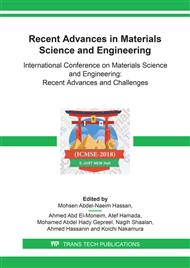p.286
p.293
p.302
p.314
p.319
p.325
p.335
p.342
p.348
Mechanical Properties of a “Simple Panel Structure” Manufactured of an Ultra High Strength Stainless Steel
Abstract:
Corrugated core panels contain a formed, corrugated core bonded between two skin sheets. These panels are typically used in applications, where a low weight is required with integrity in stiffness. This paper demonstrates the mechanical properties of a simple panel structure (SPS), constructed using strips of work-hardened, austenitic stainless steel (ASS) grade 1.4310 (type 301) with the yield strength (YS) of ~1200 MPa. The 0.5 mm thick strips were formed into a C-shape and subsequently laser welded together by lap joints to form a SPS. The thickness of the SPS was 50 mm. The bending tests for the SPS were carried out transverse and 45-degrees related to the orientation of the web sheet. The results showed that the SPS, as loaded in the transverse direction, has about the same bending stiffness prior yielding as that of the previously tested 6 mm thick, low carbon S355 plain steel sheets, but the SPS is three times lighter than 6mm thick plain steel sheet. Compared with a corrugated core panel made of an annealed ferritic stainless steel (SS-panel) with the YS ~ 250 MPa, the weight of the both panels are roughly the same, but the bending resistance of the SPS is 45% higher. Experimental tests also verified that the benefit in the stiffness is quickly reduced if the load direction differs from transverse. In the 45-degrees loading direction, the SPS and the SS-panel had almost the same bending strength. On the other hand, the SPS and the SS-panel stiffnesses are much better than that of the carbon steel (the YS ~ 300 MPa) panel (CS-panel) in the both loading directions – the SPS being twice as stiff as the CS-panel.
Info:
Periodical:
Pages:
319-324
Citation:
Online since:
October 2018
Authors:
Price:
Сopyright:
© 2018 Trans Tech Publications Ltd. All Rights Reserved
Share:
Citation:


